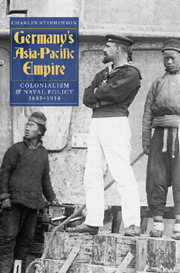Book contents
- Frontmatter
- Contents
- List of Illustrations
- List of Maps and Tables
- Introduction
- 1 Bismarck and Empire: 1885–1888. Kaiser Wilhelm's Land, the Bismarck Archipelago, the Marshall Islands and Nauru
- 2 The Acquisition of Kiautschou: 1897
- 3 China 1897–1914: Colonial Development and Political Turbulence
- 4 Tectonic Shift 1: 1898–1899. Spain and the USA, Germany, Micronesia and Samoa
- 5 Tectonic Shift 2: 1902–1914. Japan and Russia, Britain and Dominion Defence, the United States
- 6 War. August 1914
- 7 Naval Plans and Operations 1897–1914
- 8 Kiautschou: Naval and Military Operations 22 August–28 September 1914
- 9 Tsingtau: Naval and Military Operations 28 September–7 November 1914
- 10 Aftermath
- Notes to the Text
- Bibliography
- Index
8 - Kiautschou: Naval and Military Operations 22 August–28 September 1914
Published online by Cambridge University Press: 12 September 2012
- Frontmatter
- Contents
- List of Illustrations
- List of Maps and Tables
- Introduction
- 1 Bismarck and Empire: 1885–1888. Kaiser Wilhelm's Land, the Bismarck Archipelago, the Marshall Islands and Nauru
- 2 The Acquisition of Kiautschou: 1897
- 3 China 1897–1914: Colonial Development and Political Turbulence
- 4 Tectonic Shift 1: 1898–1899. Spain and the USA, Germany, Micronesia and Samoa
- 5 Tectonic Shift 2: 1902–1914. Japan and Russia, Britain and Dominion Defence, the United States
- 6 War. August 1914
- 7 Naval Plans and Operations 1897–1914
- 8 Kiautschou: Naval and Military Operations 22 August–28 September 1914
- 9 Tsingtau: Naval and Military Operations 28 September–7 November 1914
- 10 Aftermath
- Notes to the Text
- Bibliography
- Index
Summary
The position of Kiautschou, in military and naval terms, was hopeless once Japan entered the war; geography and force disparity ensured that German retention of the territory was impossible. The German administration, under the leadership of Governor Meyer-Waldeck had little in the way of resources with which to defend the area from the military and naval power that the Japanese could deploy.
The ultimatum delivered to Germany expired on 23 August, but Meyer-Waldeck had been making preparations for a potential outbreak of hostilities against an unknown enemy or enemy combination for some time previously. He had been kept abreast of the deteriorating situation in Europe following the assassination of Archduke Franz Ferdinand in Sarajevo on 28 June. For example, on 27 July he had been warned, by a message received from his superiors in Berlin, that Austria-Hungary and Serbia had severed diplomatic relations, and that the international situation was tense. He therefore initiated precautionary measures involving the recall of outlying forces in China to the Kiautschou Territory. The principal force in this respect being the East Asiatic Marine Detachment, which, under the terms of the Boxer Protocol of 1901, constituted the German component of the foreign forces stationed in the Chinese capital and at various key points along the route to Beijing. This force, with a nominal strength of four companies of infantry and supporting arms, including artillery, was thus ordered to proceed to Kiautschou from Tientsin and Beijing.
- Type
- Chapter
- Information
- Germany's Asia-Pacific EmpireColonialism and Naval Policy, 1885–1914, pp. 131 - 152Publisher: Boydell & BrewerPrint publication year: 2009



